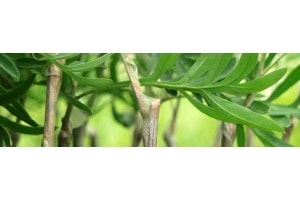
Butterflies are one of the magical transformations of nature - how does a crawling caterpillar completely recreate itself into a shimmering floating pollinator? You can encourage butterflies to your garden and help their numbers increase, with the plants you choose.
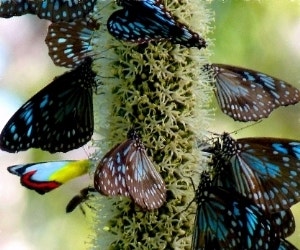 Butterflies come from caterpillars. That much we know. So in order to have beautiful butterflies, we must also have munching caterpillars - not such a welcome prospect for most gardeners! If you can, leave a patch of weeds and butterfly-friendly plants in an out-of-the-way corner of your garden, so that butterflies can lay their eggs safely, and their caterpillars can eat the weeds in peace. You might spot these eggs laid singly or in clusters on the underside of leaves - tiny green, yellow, orange or white ovals.
Butterflies come from caterpillars. That much we know. So in order to have beautiful butterflies, we must also have munching caterpillars - not such a welcome prospect for most gardeners! If you can, leave a patch of weeds and butterfly-friendly plants in an out-of-the-way corner of your garden, so that butterflies can lay their eggs safely, and their caterpillars can eat the weeds in peace. You might spot these eggs laid singly or in clusters on the underside of leaves - tiny green, yellow, orange or white ovals.
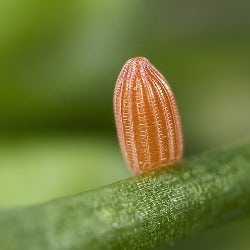 Think about planting for caterpillars as well as for butterflies. Caterpillar-friendly plants, and those that butterflies like to lay their eggs on, are varied and attractive in a garden setting. Butterfly-friendly nectar plants are easy for gardeners to incorporate into beds and borders, as many nectar-rich blossoms are also very pretty and make excellent garden plants. There are many butterfly-friendly plants that make great additions to an outdoor space for us, and our pollinator friends, and we've collected some of the best plants for butterflies here.
Think about planting for caterpillars as well as for butterflies. Caterpillar-friendly plants, and those that butterflies like to lay their eggs on, are varied and attractive in a garden setting. Butterfly-friendly nectar plants are easy for gardeners to incorporate into beds and borders, as many nectar-rich blossoms are also very pretty and make excellent garden plants. There are many butterfly-friendly plants that make great additions to an outdoor space for us, and our pollinator friends, and we've collected some of the best plants for butterflies here.
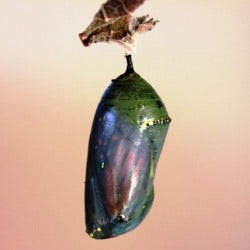 /pbr>They need to have this superpower, as baby caterpillars are super-fussy about what they will and won't eat, and some butterfly species are limited to only one or two plants to lay their eggs on to ensure the next generation survives.
Different butterflies have different preferences for their egg-laying, so to attract the widest range of butterflies, a wide range of plants is best. And if you're lucky, you'll see tiny eggs attached to the undersides of the leaves, and maybe even a chrysalis. Some chrysalises are very beautiful, some are even shiny metallic, like silver and gold jewels.
/pbr>They need to have this superpower, as baby caterpillars are super-fussy about what they will and won't eat, and some butterfly species are limited to only one or two plants to lay their eggs on to ensure the next generation survives.
Different butterflies have different preferences for their egg-laying, so to attract the widest range of butterflies, a wide range of plants is best. And if you're lucky, you'll see tiny eggs attached to the undersides of the leaves, and maybe even a chrysalis. Some chrysalises are very beautiful, some are even shiny metallic, like silver and gold jewels.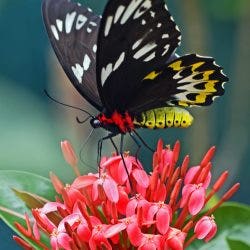 Like bees, butterflies prefer flat open flowers that they can land on easily, and easily drink the nectar from with their curly proboscis. Imagine the difference between drinking through a straw from a wide plain glass, or from a tall skinny one stuffed with fruit slices and ice cubes! Butterflies and other pollinators don't enjoy blousy double flowers as these make it tricky - or sometimes impossible - for them to access nectar. Look for flowers that have the simple shape of a daisy, with a small amount of petals around a central 'eye'. So mix it up in your borders - plant some frilly flowers for you, and some flat flowers for the butterflies.
Like bees, butterflies prefer flat open flowers that they can land on easily, and easily drink the nectar from with their curly proboscis. Imagine the difference between drinking through a straw from a wide plain glass, or from a tall skinny one stuffed with fruit slices and ice cubes! Butterflies and other pollinators don't enjoy blousy double flowers as these make it tricky - or sometimes impossible - for them to access nectar. Look for flowers that have the simple shape of a daisy, with a small amount of petals around a central 'eye'. So mix it up in your borders - plant some frilly flowers for you, and some flat flowers for the butterflies.
 Butterflies also enjoy feeding on flowers where the blooms are grouped in clusters, as it cuts down on their travelling time :
Butterflies also enjoy feeding on flowers where the blooms are grouped in clusters, as it cuts down on their travelling time :

How to garden for butterflies
 Butterflies come from caterpillars. That much we know. So in order to have beautiful butterflies, we must also have munching caterpillars - not such a welcome prospect for most gardeners! If you can, leave a patch of weeds and butterfly-friendly plants in an out-of-the-way corner of your garden, so that butterflies can lay their eggs safely, and their caterpillars can eat the weeds in peace. You might spot these eggs laid singly or in clusters on the underside of leaves - tiny green, yellow, orange or white ovals.
Butterflies come from caterpillars. That much we know. So in order to have beautiful butterflies, we must also have munching caterpillars - not such a welcome prospect for most gardeners! If you can, leave a patch of weeds and butterfly-friendly plants in an out-of-the-way corner of your garden, so that butterflies can lay their eggs safely, and their caterpillars can eat the weeds in peace. You might spot these eggs laid singly or in clusters on the underside of leaves - tiny green, yellow, orange or white ovals.
 Think about planting for caterpillars as well as for butterflies. Caterpillar-friendly plants, and those that butterflies like to lay their eggs on, are varied and attractive in a garden setting. Butterfly-friendly nectar plants are easy for gardeners to incorporate into beds and borders, as many nectar-rich blossoms are also very pretty and make excellent garden plants. There are many butterfly-friendly plants that make great additions to an outdoor space for us, and our pollinator friends, and we've collected some of the best plants for butterflies here.
Think about planting for caterpillars as well as for butterflies. Caterpillar-friendly plants, and those that butterflies like to lay their eggs on, are varied and attractive in a garden setting. Butterfly-friendly nectar plants are easy for gardeners to incorporate into beds and borders, as many nectar-rich blossoms are also very pretty and make excellent garden plants. There are many butterfly-friendly plants that make great additions to an outdoor space for us, and our pollinator friends, and we've collected some of the best plants for butterflies here.
Best Butterfly-Friendly Plants For Egg-Laying
 /pbr>They need to have this superpower, as baby caterpillars are super-fussy about what they will and won't eat, and some butterfly species are limited to only one or two plants to lay their eggs on to ensure the next generation survives.
Different butterflies have different preferences for their egg-laying, so to attract the widest range of butterflies, a wide range of plants is best. And if you're lucky, you'll see tiny eggs attached to the undersides of the leaves, and maybe even a chrysalis. Some chrysalises are very beautiful, some are even shiny metallic, like silver and gold jewels.
/pbr>They need to have this superpower, as baby caterpillars are super-fussy about what they will and won't eat, and some butterfly species are limited to only one or two plants to lay their eggs on to ensure the next generation survives.
Different butterflies have different preferences for their egg-laying, so to attract the widest range of butterflies, a wide range of plants is best. And if you're lucky, you'll see tiny eggs attached to the undersides of the leaves, and maybe even a chrysalis. Some chrysalises are very beautiful, some are even shiny metallic, like silver and gold jewels.
- acacia - for emperor, hairstreak, grass-yellow, and line blue
- breynia
- bottlebrush (Callistemon)
- brush box (Lophostemon)
- bush pea (Pultenaea) - for heath blue, pea blue, grass blue
- citrus : orange, lemon, lime, kumquat - for citrus swallowtails, including Ulysses
- elaeocarpus
- euodia (Melicope)
- fan flower (Scaevola) - for meadow argus
- weeping fig, creeping fig, rubber plant, fiddleleaf fig (Ficus)
- flame tree (Brachychiton)
- flax lily (Dianella) - for southern dart
- native ginger (Alpinia)
- goodenia - for meadow argus
- paperbark & honey myrtle (Melaleuca)
- poa grass - for skippers
- purple coral pea (Hardenbergia) - for grass blue
- salt bush (Rhagodia) - for saltbush blue
- yellow buttons (Chrysocephalum) - for painted lady

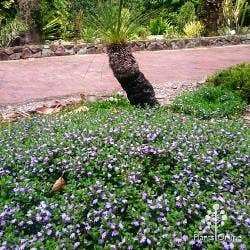

Best Butterfly-Friendly Plants For Nectar
 Like bees, butterflies prefer flat open flowers that they can land on easily, and easily drink the nectar from with their curly proboscis. Imagine the difference between drinking through a straw from a wide plain glass, or from a tall skinny one stuffed with fruit slices and ice cubes! Butterflies and other pollinators don't enjoy blousy double flowers as these make it tricky - or sometimes impossible - for them to access nectar. Look for flowers that have the simple shape of a daisy, with a small amount of petals around a central 'eye'. So mix it up in your borders - plant some frilly flowers for you, and some flat flowers for the butterflies.
Like bees, butterflies prefer flat open flowers that they can land on easily, and easily drink the nectar from with their curly proboscis. Imagine the difference between drinking through a straw from a wide plain glass, or from a tall skinny one stuffed with fruit slices and ice cubes! Butterflies and other pollinators don't enjoy blousy double flowers as these make it tricky - or sometimes impossible - for them to access nectar. Look for flowers that have the simple shape of a daisy, with a small amount of petals around a central 'eye'. So mix it up in your borders - plant some frilly flowers for you, and some flat flowers for the butterflies.
 Butterflies also enjoy feeding on flowers where the blooms are grouped in clusters, as it cuts down on their travelling time :
Butterflies also enjoy feeding on flowers where the blooms are grouped in clusters, as it cuts down on their travelling time :
- buddleia, the butterfly bush
- fruity-coloured ixora
- English, French and Italian lavender
- salvia the flowering sage
- autumn-flowering sedum
Be Kind To Butterflies

- Limit the use of pesticides and herbicides in your garden as these can be toxic to butterflies - our eco-friendly range of garden sundries is ideal.
- Limit the use of fertilisers in the area where caterpillar-friendly plants are located, as butterflies and their caterpillars are very sensitive to fertiliser in their food.
- If you see a caterpillar, leave it be! It will turn into a butterfly, or provide a tasty snack for a passing native bird... If you can move the caterpillar without touching it, relocate it to plants you don't mind being munched on.
- Leave patches of weeds and butterfly-friendly plants for them to lay eggs on - like this vineyard has done - to create the next generation of flying jewels.

























